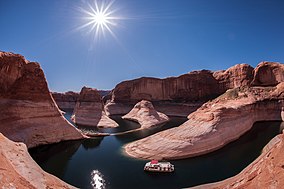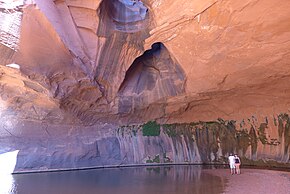
Back Glen Canyon National Recreation Area CEB Glen Canyon National Recreation Area German منطقه تفریحی و ملی گلن کنیون Persian Glen Canyon National Recreation Area French אזור הנופש הלאומי קניון גלן HE Glen Canyon National Recreation Area Dutch
| Glen Canyon National Recreation Area | |
|---|---|
 Reflection Canyon | |
| Location | Kane, San Juan, Garfield, and Wayne counties, Utah & Coconino County, Arizona, United States |
| Nearest city | Page, Arizona, Bullfrog, Utah |
| Coordinates | 36°59′37″N 111°29′13″W / 36.99361°N 111.48694°W |
| Area | 1,254,117 acres (5,075.23 km2)[1] |
| Established | October 27, 1972 |
| Visitors | 5,206,934 (in 2023)[2] |
| Governing body | National Park Service, Bureau of Reclamation |
| Website | Glen Canyon National Recreation Area |

Glen Canyon National Recreation Area (shortened to Glen Canyon NRA or GCNRA) is a national recreation area and conservation unit of the United States National Park Service that encompasses the area around Lake Powell and lower Cataract Canyon in Utah and Arizona, covering 1,254,429 acres (5,076.49 km2) of mostly rugged high desert terrain. The recreation area is named for Glen Canyon, which was flooded by the Glen Canyon Dam, completed in 1966, and is now mostly submerged beneath the waters of Lake Powell.
Glen Canyon NRA borders Capitol Reef National Park and Canyonlands National Park on the north, Grand Staircase–Escalante National Monument on the west, Vermilion Cliffs National Monument and the northeasternmost reaches of Grand Canyon National Park on the southwest, and the Navajo Nation on the southeast. The southwestern end of Glen Canyon NRA in Arizona can be accessed via U.S. Route 89 and State Route 98. State Route 95 and State Route 276 lead to the northeastern end of the recreation area in Utah.
Glen Canyon NRA was established in 1972 "to provide for public use and enjoyment and to preserve the area's scientific, historic, and scenic features." The stated purpose of Glen Canyon NRA is for recreation as well as preservation (whereas a national park may carry more emphasis on natural preservation). As such, the area has been developed for access to Lake Powell via five marinas, four public campgrounds, two small airports, and numerous houseboat rental concessions.
- ^ "Listing of acreage – December 31, 2011" (XLSX). Land Resource Division, National Park Service. Retrieved 2012-12-14. (National Park Service Acreage Reports)
- ^ "NPS Annual Recreation Visits Report". National Park Service. Retrieved 2024-04-11.
© MMXXIII Rich X Search. We shall prevail. All rights reserved. Rich X Search

